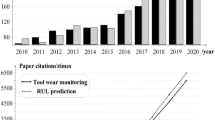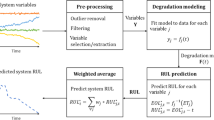Abstract
Prognostics and health management (PHM) methods aim at detecting the degradation, diagnosing the faults and predicting the time at which a system or a component will no longer perform its desired function. PHM is based on access to a model of a system or a component using one or combination of physical or data-driven models. In physical-based models, one has to gather a lot of knowledge about the desired system and then build an analytical model of the system function of the degradation mechanism that is used as a reference during system operation. On the other hand, data-driven models are based on the exploitation of symptoms or indicators of degradations using statistical or artificial intelligence methods on the monitored system once it is operational and learn the normal behaviour. Trend extraction is one of the methods used to extract important information contained in the sensory signals, which can be used for data-driven models. However, extraction of such information from the collected data in a practical working environment is always a great challenge as sensory signals are usually multidimensional and obscured by noise. Also, the extracted trends should represent the nominal behaviour of the system as well as the health status evolution. This paper presents a method for nonparametric trend modelling from multidimensional sensory data so as to use such trends in machinery health prognostics. The goal of this work is to develop a method that can extract features representing the nominal behaviour of the monitored component, and from these features, smooth trends are extracted to represent the critical component’s health evolution over the time. The proposed method starts by multidimensional feature extraction from machinery sensory signals. Then, unsupervised feature selection on the features’ domain is applied without making any assumptions concerning the number of the extracted features. The selected features can be used to represent the nominal behaviour of the system and hence detect any deviation. Then, empirical mode decomposition algorithm is applied on the projected features with the purpose of following the evolution of data in a compact representation over time. Finally, ridge regression is applied to the extracted trend for modelling and can be used later for the remaining useful life prediction. The method is demonstrated on accelerated degradation data set of bearings acquired from PRONOSTIA experimental platform and another data set downloaded from NASA repository where it is shown to be able to extract signal trends.
Similar content being viewed by others
References
Agogino A, Tumer K (2006) Entropy based anomaly detection applied to space shuttle main engines. IEEE aerospace conference
Brown D, Georgoulas G, Chen R, Ho YH, Tannenbaum G, Schroeder J (2009) Particle filter based anomaly detection for aircraft actuator system. IEEE aerospace conference, Monatan
Camci F, Medjaher K, Zerhouni N, Nectoux P (2012) Feature evaluation for effective bearing prognostics. Quality and reliability engineering international 29. Article first published online: 16 Mar 2012. doi:10.1002/qre.1396
Cempel C (2003) Multidimensional condition monitoring of mechanical systems in operation. Mech Syst Signal Process 17:1291–1303
Cempel C (2003) Multifault condition monitoring of mechanical systems in operation, vol 17. IMEKO XVII, Croatia, pp 1–4
Charbonnier S, Garcia-Beltan C, Cadet C, Gentil S (2005) Trends extraction and analysis for complex system monitoring and decision support. Eng Appl Artif Intel 18:21–36
Cottrell M, Gaubert P, Eloy C, Franscois D, Hallaux G, Lacaille J, Verleysen M (2009) Fault prediction in aircraft engines using selforganizing maps. Proceedings of the 7th international workshop on advances in self-organizing maps, pp 37–44
Filev DP, Tseng F (2006) Novelty detection based machine health prognostics. Int Symp Evolving Fuzzy Syst 193–199
Geramifard O, Xu JX, Pang CK, Zhou JH, Li X (2010) Data-driven approaches in health condition monitoring—a comparative study. 8th IEEE international conference on control and automation, pp 1618–1622
Geramifard O, Xu JX, Zhou JH, Li X (2010) Continuous health assessment using a single hidden Markov model. 11th international conference on control automation robotics and vision, pp 1347–1352
Geramifard O, Xu JX, Zhou JH, Li X (2011) Continuous health condition monitoring: a single hidden semi-Markov model approach. IEEE conference on prognostics and health management, pp 1–10
Heng A, Zhang S, Tan ACC, Mathew J (2009) Rotating machinery prognostics: state of the art, challenges and opportunities. Mech Syst Signal Process 23:724–739
Heng R, Nor M (1998) Statistical analysis of sound and vibration signals for monitoring rolling element bearing condition. Appl Acoust 53:211–226
Huang NE, Shen Z, Long SR, Wu MC, Shih HH, Zheng Q, Yen NC, Tung CC, Liu HH (1998) The empirical mode decomposition and the Hilbert spectrum for nonlinear and non-stationary time series analysis. Proc R Soc London 454:903–995
ISO, Condition Monitoring and Diagnostics of Machines - Prognostics part 1: General Guidelines, (2004) In: ISO13381–1:2004(E). Volume: ISO/IEC Directives Part 2, Page 14
Jardine AKS, Lin D, Banjevic D (2006) A review on machinery diagnostics and prognostics implementing condition-based maintenance. Mech Syst Signal Process 20:1483–1510
Jiang H, Penman J (1993) Using Kohonen feature maps to monitor the condition of synchronous generators. Workshop on neural network applications and tools, pp 89–94
Jie S, Hong GS, Rahman M, Wong YS (2002) Feature extraction and selection in tool condition monitoring system. Advances in artificial intelligence, pp 487–497
Jolliffe IT (2002) Principal component analysis and factor analysis, chap 7. Principal component analysis. Springer series in statistics, pp 150–166. Springer, New York
Kothamasu R, Huang SH, VerDuin WH (2006) System health monitoring and prognostics: a review of current paradigms and practices. Int J Adv Manuf Technol 28:1012–1024
Li R, Sopon P, He D (2012) Fault features extraction for bearing prognostics. J Intell Manuf 313–321
Medjaher K, Tobon-Mejia D, Zerhouni N (2012) Remaining useful life estimation of critical components with application to bearings. IEEE Trans Reliab 61:292–302
Miao Q, Wang D, Pecht M (2010) A probabilistic description scheme for rotating machinery health evaluation. J Mech Sci Technol 24:2421–2430
Mosallam A, Byttner S, Svensson MTR (2011) Nonlinear relation mining for maintenance prediction. IEEE aerospace conference, pp 1–9. doi:10.1109/AERO.2011.5747581
Moshou D, Kateris D, Sawalhi N, Loutridis S, Gravalos I (2010) Fault severity estimation in rotating mechanical systems using feature based fusion and self-organizing maps. Artificial Neural Networks, pp 410–413
Nectoux P, Gouriveau R, Medjaher K, Ramasso E, Chebel-Morello B, Zerhouni N, Varnier C (2012) PRONOSTIA: an experimental platform for bearings accelerated degradation tests. IEEE international conference on prognostics and health management, PHM’12, Denver
Ocak H, Loparo KA, Discenzo FM (2007) Online tracking of bearing wear using wavelet packet decomposition and probabilistic modeling: a method for bearing prognostics. J Sound Vib 302:951–961
Pontoppidan NH, Larsen J (2003) Unsupervised condition change detection in large diesel engines. IEEE 13th workshop on neural networks for signal processing, pp 565–574
Saha B, Goebel K, Poll S, Christophersen J (2009) Prognostics methods for battery health monitoring using a Bayesian framework. IEEE Trans Instrum Meas 58:291–296
Saha B, Goebel K, Poll S, Christopherson J (2007) A Bayesian framework for remaining useful life estimation. Proceedings Fall AAAI symposium: AI for prognostics. Arlington
Schwabacher M (2005) A survey of data-driven prognostics. AIAA InfoTech Aerospace
Svensson M, Rognvaldsson T, Byttner S, West M, Andersson B (2011) Unsupervised deviation detection by GMM—a simulation study. IEEE international symposium on diagnostics for electric machines, power electronics and drives, pp 51–54
Tavares G, Zsigraiova Z, Semiao V, da Graca Carvalho M (2011) Monitoring, fault detection and operation prediction of MSW incinerators using multivariate statistical methods. Waste Manag 31:1635–1644
Tobon-Mejia D, Medjaher K, Zerhouni N, Tripot G (2012) A data-driven failure prognostics method based on mixture of Gaussians hidden Markov models. IEEE Trans Reliab 61:491–503
Wald R, Khoshgoftaar TM, Sloan JC (2011) Using feature selection to determine optimal depth for wavelet packet decomposition of vibration signals for ocean system reliability. IEEE 13th international symposium on high-assurance systems engineering, pp 236–243
Ying P, Ming D, Ming JZ (2010) Current status of machine prognostics in condition-based maintenance: a review. Int J Adv Manuf Technol, 50:297–313
Yang Z, Zhong J, Wong SF (2011) Machine learning method with compensation distance technique for gear fault detection. 9th world congress on intelligent control and automation, pp 632–637
Zhang S (1994) Function estimation for multiple indices trend analysis using self-organizing mapping. IEEE symposium on emerging technologies and factory automation, pp 160–165
Zhang S, Hodkiewicz M, Ma L, Mathew J, Kennedy J, Tan A, Anderson D (2006) Machinery condition prognosis using multivariate analysis. Engineering asset management, pp 847–854
Zhang X, Xu R, Kwan C, Liang S, Xie Q, Haynes L (2005) An integrated approach to bearing fault diagnostics and prognostics. Proceedings of the 2005 American control conference, pp 2750–2755
Zhou JH, Pang CK, Lewis FL, Zhong ZW (2009) Intelligent diagnosis and prognosis of tool wear using dominant feature identification. IEEE Trans Ind Inform 454–464
Author information
Authors and Affiliations
Corresponding author
Rights and permissions
About this article
Cite this article
Mosallam, A., Medjaher, K. & Zerhouni, N. Nonparametric time series modelling for industrial prognostics and health management. Int J Adv Manuf Technol 69, 1685–1699 (2013). https://doi.org/10.1007/s00170-013-5065-z
Received:
Accepted:
Published:
Issue Date:
DOI: https://doi.org/10.1007/s00170-013-5065-z




